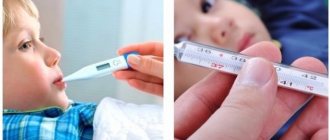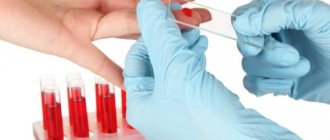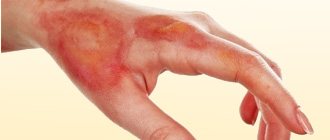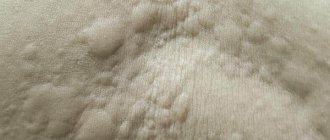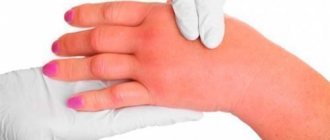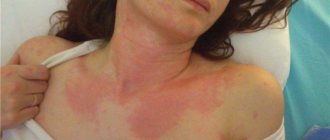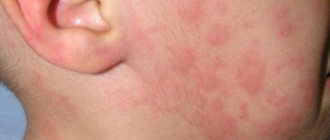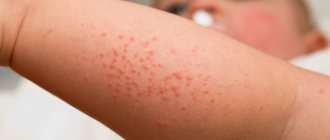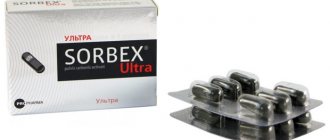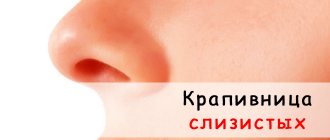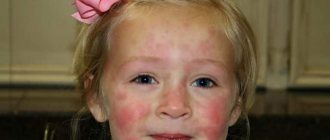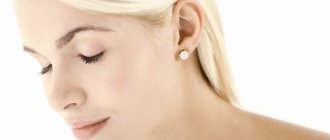With the arrival of warm days, everyone strives to leave the city limits and go on vacation to the sea. The older generation prefers summer cottages, quiet, peaceful work in gardens and orchards. Previously, we only risked getting hay fever during this period of time. But the rapid development of technologies that affect the ecology and condition of our body is introducing more and more new diseases. Thus, allergies to ultraviolet radiation have become quite widespread. And the main inconvenience from it is solar urticaria.
What is solar urticaria?
solar urticaria
Solar urticaria is a disease that occurs when exposed to ultraviolet radiation.
When it appears, a person reacts painfully to the sun's rays. The symptoms that can be seen in the photo are expressed in the form of a red rash. If the disease appears, it is important to consult a doctor who will prescribe comprehensive treatment. Solar urticaria, a disease that manifests itself under the influence of ultraviolet radiation. Solar urticaria is called an allergic reaction to the sun. It can appear 15 minutes after exposure to sunlight or an hour. As a result of the negative impact, a rash in the form of blisters forms on the skin. Sometimes symptoms, which can be studied in photos on the Internet, appear the next day after prolonged exposure to the open sun. The disease affects one fifth of the population. Solar urticaria can vary in intensity depending on the sensitivity of the skin and the duration of exposure to ultraviolet light.
Symptoms appear on exposed areas of the body that have been most affected by negative influences. Also, a rash often forms on the surface of the skin covered with thin fabrics (chiffon, silk). The symptoms of solar urticaria, which can be seen in the photo below, appear quite clearly.
After exposure to the sun, red spots like erythema appear on exposed areas of the body (arms, legs, face, neck). If the influence of the negative factor is not eliminated in time and treatment is not started, they turn into small blisters. The rash may be very itchy. There is also a burning sensation.
In addition to the typical signs of urticaria, which can be seen in the photo, other symptoms of the disease appear. These include: increased body temperature; weakness; headache; loss of consciousness; lack of air.
Such signs are considered rare and not typical in common cases. However, doctors note that if the body reacts strongly, angioedema may appear. In this case, you should not hesitate to consult a doctor in order to prevent serious complications. It is important to start treatment of the disease on time, which should be comprehensive.
Blisters and rashes usually resolve on their own if exposure to sunlight is avoided. However, symptoms may reappear if the person goes out into the sun. Solar urticaria more often appears in people with Celtic skin type, photos of which are presented on the Internet. They tan poorly, which causes red spots and burns to appear on the surface of the skin.
Pregnant women and children are also particularly susceptible to the disease. The occurrence of the disease, the signs of which can be seen in the photo, is caused by a malfunction of the body’s immune system. Photodermatosis also often appears when the functioning of the liver, kidneys and gastrointestinal tract is disrupted. The disease can occur when consuming foods that trigger the photosensitization process.
Also, the allergic reaction, which is shown in the photo, appears under the influence of certain plants and herbs. They are found in medicines, cosmetics, and food. In addition, essential oils and medications can have irritating properties.
The latter are especially dangerous, therefore, when exposed to the sun for a long time, people at risk are prohibited from taking antibiotics, fungal remedies, hormones, and antidepressants. If signs of illness appear, the patient should be examined by a doctor. Depending on the symptoms, the necessary treatment will be prescribed.
Treatment for solar urticaria begins with taking antihistamines. In case of illness, doctors most often resort to using remedies that belong to the new generation. The drug Erius helps block histamine and eliminate the inflammatory process on the surface of the skin. It can be used during pregnancy due to the absence of side effects.
To relieve itching and inflammation, you can take Kestin. In addition, it has an antiseptic effect. The disadvantage of the drug is the presence of negative reactions with the wrong dosage and duration of therapy. With pronounced symptoms of the disease, the use of external agents is required.
Treatment can be carried out using non-hormonal (Fenistil-gel, Bepanten, D-panthenol, Gistan) and hormonal (Elocom, Soderm, Flucinar, Advantan) drugs. The latter have the most powerful effect on the body, eliminating symptoms in a short period of time. However, if there are wounds, they should not be used.
They can enter the bloodstream, disrupting the hormonal balance in the body. The advantage of non-hormonal therapy is its availability for all categories of patients. Such ointments and creams are allowed to be used by pregnant and lactating women and children.
They cool the surface of the skin, eliminating itching, burning and redness. If peeling occurs, you can lubricate the damaged surface of the skin with any cosmetic product with high fat content. Children's cream copes well with the task. If a person once develops characteristic symptoms, as in the photo, then it is worth remembering preventive measures.
If they are followed, the risk of recurrent manifestations of solar urticaria is significantly reduced. You should avoid walking in direct sunlight. You should go outside in the morning or evening, when the sun is not so scorching. People who suffer from the disease are advised to reconsider their own wardrobe. It should consist of light-colored clothing.
It is also recommended to purchase hats with brims, sunglasses, and umbrellas for sun protection. Before walking, you should apply a high-protection sunscreen to your skin. It is worth reviewing cosmetic products that are used regularly. They must not contain substances that may cause photosensitivity.
In order to prevent relapses, it is important to adhere to a plant-based diet, as well as a drinking regime. A person needs to drink at least 2 liters of water per day. If you follow all the preventative measures for solar urticaria, you can forget about blisters and itching for a long time.
If all preventive recommendations are followed, then reducing the risk of recurrent manifestations of solar urticaria will not be difficult. It is worth remembering that the disease cannot be treated, so relapses may occur again when exposed to dangerous sunlight.
Source: allergiyainfo.ru
Treatment prognosis and prevention
At the first manifestations, solar urticaria is treated with creams. It is necessary to find out the reason and eliminate the use of decorative cosmetics. Usually the manifestations pass quickly, leaving no traces or scars on the skin.
There are cases when the disease appears suddenly in adults in one summer season, and the next year no symptoms are observed after prolonged exposure to the sun. What determines the frequency of the disease in different summer periods has not been precisely established. Perhaps the state of the immune system and the use of cosmetics influence it.
If a sun allergy occurs, the treatment prognosis is favorable if the patient follows all the doctor’s recommendations and prescriptions. Complications in the form of loss of consciousness are observed in only 2-3% of people suffering from sun allergies.
Types of disease
There are two forms of urticaria: Immune (allergic) urticaria - develops with the participation of the immune system, accompanied by the active formation of antibodies and the release of histamine. Combined with pathology of the digestive system. Without pathology of the digestive organs.
As a result of many years of studying the factors that cause urticaria, scientists have obtained the following data: 60% of patients have a hereditary predisposition to this disease.
Non-immune (pseudo-allergic) urticaria occurs without the participation of the immune system and is caused by: previously suffered severe intoxication of the body (malaria, dysentery, mushroom poisoning, etc.); hypersensitivity to drugs; infection with parasitic worms (ascariasis, giardiasis).
When compiling an anamnesis, it was found that in 70% of people the development of the disease was preceded by exudative diathesis. Pathological diseases of the digestive system (intestinal dysbiosis, infection with parasitic organisms) are typical for 94% of those studied.
40% of patients had permanent foci of infection in the body (dental caries, chronic inflammation of the tonsils, etc.). Analyzing the above information, we can conclude that the disease urticaria develops in people predisposed to allergic reactions in the presence of disorders in the digestive system.
Allergic urticaria
This type of urticaria can be caused by various allergens: Food allergens: eggs, sugar, citrus fruits, potatoes, chocolate, etc. Often the culprits of the disease are several products at once, especially with a long-term chronic course of the disease.
Medicinal allergens: antibiotics, B vitamins. Epidermal allergens: dandruff, pet hair. The acute period of allergenic urticaria lasts several hours until contact with allergens stops.
With food allergies, periods of exacerbation alternate with periods of remission until allergenic foods are completely eliminated from the diet.
Pseudo-allergic
Pseudoallergic urticaria is a disease that develops without the participation of the human immune system. Accordingly, no increase in antibody levels is observed during this process.
Pseudoallergic urticaria is manifested by the action of external and internal factors (temperature, physical activity, bacterial infection), but the formation of an antigen-antibody complex and the production of immunoglobulins JE does not occur.
Cold
Cold urticaria most often develops under the influence of low ambient temperatures. On cooled areas of the body (most often on the face and hands), blisters, a burning sensation, and swelling appear. The allergic reaction reaches its maximum manifestation during the period of warming up of the victim.
In most cases, cold allergy symptoms go away within 50-60 minutes, sometimes lasting up to 5-7 days. Cold drinks and ice cream can also trigger cold urticaria.
Cholinergic urticaria
Cholinergic urticaria develops under the influence of elevated body temperature. An increase in temperature can be caused by physical activity, drinking hot drinks, or taking water procedures.
The allergic reaction is characterized by the appearance of itchy pink blisters all over the body. The true causes of the disease have not been precisely established, but those suffering from cholinergic urticaria are often diagnosed with: pathologies of the digestive tract; helminth infections; dysfunction of the thyroid gland.
Nervous
Nervous urticaria is another form of pseudoallergic urticaria. The triggering factors are nervous tension, excitement, stress, and fear.
The symptoms are the same as for other types of urticaria. First, flesh-colored blisters appear, then redness of the rash is observed.
There are also solar urticaria, mechanical urticaria, and aquaurticaria, which develop respectively under the influence of sunlight, mechanical damage and water.
Source: allergy-cure.ru
Causes
Solar urticaria refers to pseudoallergic urticaria, since antibodies characteristic of an allergic reaction are not detected in the blood of patients. It is believed that the release of histamine, under the influence of which allergy symptoms occur, occurs under the influence of substances - photosensitizers that are on or in the patient’s skin. The components of creams or deodorants applied to the skin may be photosensitizers on the skin. Photosensitizers located inside the skin are toxic substances that are formed in the body during diseases of the liver, kidneys or thyroid gland.
Medicines such as sulfonamides, tetracycline antibiotics, oral contraceptives, and even St. John's wort decoction can also cause photosensitivity. If photodermatitis occurs due to photosensitizers found in cosmetics, then red spots on the skin will be clearly defined.
If an allergy to the sun occurs due to the use of medications or diseases of the internal organs, the manifestations of urticaria will appear on open areas of the skin and will be located symmetrically. Women suffer from solar urticaria 4 times more often than men. People with fair skin are at particular risk.
Also, the risk of developing solar urticaria is higher in those people who have a family history of photodermatosis (i.e., urticaria can be inherited). Allergy to the sun more often occurs in people who live far from the equator in the northern regions.
Source: dermatologpro.ru
Symptoms and signs
The disease has two forms: Acute; Chronic. The acute stage is characterized by sudden onset of symptoms, which may appear 15-20 minutes after exposure to sunlight on an exposed area of skin. In the chronic course of the disease, symptoms appear gradually and may not go away for days.
Below are general symptoms for all people; they can vary greatly depending on the individual characteristics of a person - his age, gender, health status.
Redness of the skin. A patient with solar urticaria develops red skin after several hours of exposure to the sun. Redness most often appears on the chest, abdomen, inner legs, and buttocks. There may be no redness on the arms, outer legs, neck and shoulders due to the fact that these areas are often exposed to the rays of the sun, so they develop immunity.
Deterioration of tone. After only 30 minutes, the patient begins to feel unwell, his temperature may suddenly rise, and a headache may appear. The appearance of blisters. If a person is exposed to the sun for more than an hour, the skin may develop pale pink blisters with blood streaks inside. After a while they merge into one large red spot.
Complications. After a few hours, the patient may feel severely unwell, nausea and chills appear, and loss of consciousness occurs. These symptoms are typical for adults and children; only in children the disease manifests itself acutely, so the child must be urgently taken indoors at the first signs of photodermatosis. Urticaria is divided into:
- Thermal – rashes from high temperature;
- Cold - appears due to being in the cold;
- Demographic or mechanical - appears due to friction on the skin or other mechanical impacts;
- Idiopathic – appears due to psychological problems;
- Allergic – caused by a specific allergen;
- Solar – reaction to ultraviolet rays.
The main difference between a “sun” disease and similar diseases is a sharp reaction to the sun’s rays. The first manifestations (redness of the skin) are noticeable after half an hour of a person’s exposure to ultraviolet streams. Watch the video to understand the essence of the disease through the mouth of a professional doctor.
To identify photodermatosis, you need to contact either a therapist or a dermatologist. To identify solar urticaria, it is necessary to undergo a protoporphyrin test.
To identify acute photodermatosis, you need to take tests, undergo ultrasound and fluoroscopy, but still the result depends on the doctor’s experience, since the disease is extremely difficult to diagnose due to the abundance of analogues and related factors. If the final indicator exceeds the norm by 20 times, the person is sick with photodermatosis, and the disease has been inherited.
Source: bezallergii.info
Diagnostics
The process of diagnosing solar urticaria or photodermatosis combines a whole range of measures.
Primary diagnosis is carried out directly by a dermatologist and is aimed at:
- study of medical history;
- collection and analysis of life history - to determine which factor became a photosensitizer for a particular person;
- thorough examination and palpation of the affected areas of the skin;
- a detailed interview with the patient - this will help the clinician create a complete symptomatic picture and understand the nature of the allergy to urticaria.
Among laboratory tests, the following have the greatest diagnostic value:
- immunological tests;
- general clinical analysis of blood and urine;
- hormonal tests;
- blood biochemistry.
Instrumental diagnosis of urticaria in adults and children is necessary only to differentiate this disease from other skin ailments. Most often, patients are advised to undergo ultrasound, radiography and MRI.
Principles of treatment of solar urticaria
If a person is prone to sun allergies, then he should try to avoid being outside during the hours of maximum solar activity. You should wear clothing that can protect you as much as possible from the sun's rays. Use protective creams whenever possible.
When going outside in spring and summer, people with a tendency to photodermatitis should not use cosmetics, deodorants, or aromatic oils.
To increase your skin's sensitivity to sun rays, you can increase its adaptability by applying short-term exposure to ultraviolet rays. In order not to become a recluse who is afraid to go outside in the sun, it is necessary to undergo a course of treatment for photodermatitis.
In principle, treatment of allergies is divided into local, that is, when special ointments and preparations are applied to the affected skin, and internal, when antihistamines are taken. Local treatment Preparations containing zinc, lanolin and methyluracil are used as ointments.
Traditional medicine also has experience in treating increased sun sensitivity. To relieve itching, apply slices of fresh cucumber, potatoes, and cabbage leaves to the affected areas. If the allergy is severe, hormonal ointments are prescribed.
First of all, it is necessary to take medications that normalize metabolic processes in the body and contribute to the rapid restoration of the skin. These are vitamin preparations, with large doses of vitamins B, E and nicotinic acid.
Very often, skin inflammation and skin itching can be relieved by taking non-steroidal anti-inflammatory drugs orally, such as ordinary aspirin and indomethacin. If solar urticaria does not go away or becomes severe, then antiallergic medications are prescribed. Treatment of photodermatitis takes time, sometimes up to 3-4 weeks.
If treatment is ineffective, then repeated solar urticaria can lead to chronic solar eczema, in which bright sun is really contraindicated. Folk remedies for the treatment of photodermatitis Using so-called “Hercules baths”.
400-500 grams of oatmeal are taken, poured with boiling water, all this is infused and added to a bath of water, the temperature of the water should be the same as the temperature of the human body, about 36 degrees. Take half a tablespoon of celery juice two to three times a day.
The juice is prepared from the root of the plant, after passing it through a meat grinder and squeezing it well. Solar urticaria is treated with the juice of fresh apples, or cranberry juice mixed with Vaseline.
Skin areas with rashes are wiped with an infusion prepared from geranium leaves. Two tablespoons of crushed leaves in two glasses of water. Leave for twenty minutes. A spoonful of glycerin is mixed with a spoonful of rice starch. The resulting mixture is rubbed into areas affected by solar urticaria. A decoction of burdock roots is used as a compress.
To do this, approximately 30 grams of finely chopped roots are poured with 2-3 glasses of water and boiled for thirty minutes. To soothe itching, take baths from a decoction of pine, spruce, and fir needles. To strengthen the immune system and improve metabolism and get rid of hives, take mumiyo and chew honeycomb.
At night, areas of the body that have been exposed to sunlight and become covered with a small rash are covered with cotton clothing.
In addition, try to strengthen your immune system and harden your body, and then, by following basic safety rules, you can cope with increased sensitivity to the sun’s rays and sunbathe like everyone else. There is no need to be afraid of the sun, it should bring joy and health.
Source: nmed.org
Treatment at home
The easiest way to get rid of the itching of solar urticaria is to freeze it. Rub the damaged skin with ice cubes or something cold. Rubbing with menthol oil or mint tea will help relieve swelling. Chamomile or plain green tea is also suitable as a lotion. Try to take cool or cold showers more often.
In the refrigerator of any housewife, and especially in the summer, there is a vegetable such as a cucumber. Cut it into circles and apply it to the pimples, rubbing the juice with massage movements. You can grate it on a fine grater and use it as a compress, fixing it with a bandage for half an hour. Potatoes are an analogue of cucumber. These products will absorb all the heat and relieve swelling. During the treatment period, refrain from playing sports - do not allow your skin to sweat. Take baths with oatmeal infusion.
Eat as many diuretic foods as possible, namely watermelons, melons, grapes, apples, celery. The juice of the latter should be consumed three times a day and wiped over the body. Aloe juice will help relieve redness. Drinking plenty of water and activated charcoal will rid your body of toxins, which will speed up the healing process. The healing properties of string and lavender have long been known. Take baths with their decoctions. Prepare a weak infusion of these herbs and drink 50 grams before meals.
Medications
A cream or ointment containing hormones is highly effective in treating urticaria. However, these drugs have contraindications and certain side effects. Hormonal medications are not used on areas of the skin that have open lesions or ulcers.
Hormonal drugs
The most common hormonal ointments for urticaria, used in adults and children: Prednisolone ointment. The main component of the drug is prednisolone. It is thanks to this component that the antiallergic and anti-inflammatory effect is achieved. Among the advantages are immediate therapeutic effects, elimination of urticaria symptoms.
Among the disadvantages is individual intolerance to the drug. With prolonged use, prednisolone for external use can cause itching, burning sensation, and erythema.
It is unacceptable to use prednisolone for infectious diseases, pregnant women and women during lactation. Prednisolone may cause patches of increased hair growth on the skin. Advantan. The drug has several forms of release: fatty ointment; ointment with a balanced ratio of water and fat (for normal skin); water-based cream (if there are wet areas on the skin).
The drug belongs to the latest generation of steroid ointments and has a minimum of adverse reactions. Among the advantages is the elimination of objective and subjective manifestations of allergic reactions on the skin (redness, rashes, relieves swelling, relieves itching and burning).
Among the disadvantages are excess hair growth at the sites of application, the appearance of acne, a burning sensation and increased itching. Treatment is limited in duration. Perioral dermatitis may occur. Elokom. A drug available in the form of an ointment or cream. Apply a thin layer to the skin once a day. Advantages: has a wide therapeutic spectrum.
It has an antihistamine and anti-inflammatory effect, reduces swelling of the skin. Disadvantages: side effects are pronounced: burning sensation and itching may increase. In children and patients under 18 years of age, the function of hormone production by the adrenal cortex may be inhibited.
Soderm. Like the above listed drugs, it has several forms of release: cream, ointment, lotion. The main active ingredient is betamethasone. Used only for the treatment of urticaria in adults. Children over 1 year of age are prescribed with caution and only under medical supervision. Benefits: has good anti-inflammatory properties.
Disadvantages: dry skin and cracks may appear, increased itching and burning. Do not apply to large areas of skin. Lorinden S. Very effectively eliminates the manifestation of urticaria. Active ingredient: clioquinol. Benefits: has antifungal, antibacterial and anti-inflammatory effects.
Very quickly relieves symptoms of urticaria, such as itching and swelling. Disadvantages: impossibility of use in children. With prolonged use, atrophy of the skin is possible. Hormonal drugs also include Dexamethasone and Prednisolone, which are used in the form of injections and in tablet form for acute attacks of urticaria.
Non-hormonal ointments and creams
These drugs mainly have an antihistamine effect. They do not have pronounced side effects and can be used in the treatment of urticaria in both adults and children. Most often, doctors prefer the following drugs: Zinc ointment. Even infants can use zinc-based ointments.
They do not cause serious side effects and do not contain hormones. Advantages: have a good antimicrobial, drying and anti-inflammatory effect. Low cost of medicine.
Can be used during pregnancy and lactation. Disadvantages: in very rare cases, allergic reactions may occur, manifested by itching and increased rash. Fenistil gel. It can also be produced in the form of drops. It has an antiallergic effect and reduces capillary permeability.
Advantages: the gel is suitable for the treatment of urticaria in infants and has an antihistamine effect. Disadvantages: in very rare cases, an allergic rash may occur, accompanied by itching and redness in the area of the skin where the drugs are used. Nezulin. Gel, which contains natural ingredients.
You can smear the affected areas of the skin up to 4 times a day. Advantages: it contains only natural ingredients and can be used by people of all ages. Relieves symptoms of urticaria, such as itching, burning, redness and swelling. Disadvantages: none identified.
Treatment with ointments: basic rules
Ointment for urticaria is applied in compliance with certain rules: it is necessary to smear the affected areas of the skin 2 to 4 times a day; ointment or cream should be applied in a thin layer. It is recommended to use drugs for topical treatment only on affected areas of the skin.
When applying ointments, it is allowed to capture small areas of healthy skin adjacent to the damaged areas. After using the medications, you should wash your hands thoroughly with soap.
Pills
The mainstay of treatment for urticaria is antihistamines. These include tablets Tavegil, Suprastin, Fenkarol, Loratadine, as well as hormonal drugs Dexamethasone and Prednisolone. Suprastin can be used in the form of drops for young children or in tablets for adults. In addition, Suprastin is used for complications of urticaria such as Quincke's edema.
However, this medicine may cause drowsiness. Suprastin is prescribed to drivers with caution. Suprastin should not be prescribed to people with prostate diseases. Activated carbon takes special attention in the treatment of urticaria. It helps remove toxins from the body.
Activated carbon has a number of advantages: it is a very cheap and quite effective drug that allows you to cleanse the body of toxins. According to most allergy sufferers, activated carbon relieves allergy symptoms for a long time. Activated carbon should be taken at the rate of 1 tablet per 10 kg of weight.
Activated carbon does not treat urticaria, but only reduces the allergenic load on the body, so that the manifestations of the disease may disappear for some time. Dexamethasone may be prescribed for complications of urticaria. Dexamethasone, like other drugs in this group, is prescribed only by a doctor, mainly for adults.
Treatment is carried out under the supervision of a specialist. Dexamethasone is included in the basis of Maxitrol eye drops, which are often used to treat rhinitis caused by an allergic reaction to urticaria. Dexamethasone is prescribed only for acute manifestations of the disease, gradually reducing the dose of the drug.
Injections
Injections of the drugs Prednisolone and Dexamethasone are prescribed for treatment in a hospital. They can be administered intravenously or intramuscularly. Local administration of drugs to the affected areas in adults is possible. Also, treatment of urticaria sometimes requires administration of the drug Suprastin intramuscularly or intravenously. The drug in this form of release is prescribed when urgent relief of an allergic reaction is necessary.
Source: dermatyt.ru
ethnoscience
Let's talk about treating urticaria with folk remedies. Traditional medicine has been serving the people for centuries. Recipes that have long been known to help fight all sorts of ailments. Hives are no exception. A huge number of traditional medicine recipes come to the rescue in the fight against urticaria: 4 tsp. peppermint must be poured into a tbsp. boiling water
Let it brew for 1 hour. Drink 50 ml of decoction, but no more than 3 times a day. Take until completely cured. 50 gr. nettles must be filled with vodka (0.5 l.). Seal tightly and place in a dark place for a week.
It is necessary to stir periodically. After a week, strain. Take 1 tbsp. lie 3 times a day for 2 weeks. Wash the beets and cut into small pieces. Place in a bowl and add water. Let it brew for 6 days in a warm place. Strain and take 1 tbsp. lie per day. It is possible to wipe the rash areas with this tincture.
Dough made from rye flour can also help in the fight against hives. For this, 500 gr. mix flour with 100 gr. wormwood herbs and knead the dough in water. Leave the dough to rest for half an hour. Make cakes and apply to affected areas for 20 minutes. Then rinse with warm water. Can be repeated daily.
1 tbsp. chopped yarrow herb pour 1 tbsp. boiling water Leave for 40 minutes. Take 1/3 tbsp before meals. up to 3 times a day. Celery root is great for fighting hives. To do this, the root must be grated, then squeezed out the juice. Take this juice an hour before meals, 1 tbsp. lie up to 3 times a day. Take for 2 weeks.
It is possible to use baths with marjoram tincture. For this, 400 gr. pour marjoram with 4 liters of boiling water. Insist. Feel free to add to your bath. No less effective will be baths with tinctures of oak bark, elderberry, celandine, string, juniper, St. John's wort, valerian root, sage, chamomile, and nettle.
Take such baths until complete recovery. Spicy lovers can be treated with horseradish juice mixed with honey in equal proportions. Take up to 3 times, 1 tsp. Mix fine oatmeal, corn starch, apple cider vinegar in a ratio (1:1:1/2). Apply the resulting mass to problem areas of the skin for 20 minutes, then rinse with warm water.
Repeat until complete relief. The affected areas of the skin should be washed with soap, dried and lubricated with lemon juice. Let it dry, spread it on for another 10 minutes. Then apply a mixture of sea salt and honey in a ratio (1:4) on top for 15 minutes. Rinse with warm water. 1\2 tsp. Take crushed calamus root at night. Drink with water.
4 tsp. Pour field barnacles into the Art. boiling water Let it sit for half an hour. Use ½ tbsp. per day. Use until the disease goes away completely.
It is impossible to completely cure urticaria once and for all. However, it is possible to achieve a significant reduction in the frequency of its manifestations.
To do this, you need to follow some simple rules: do not use medications without consulting your doctor; watch your diet; Avoid severe overheating or hypothermia of the body; do not wear tight shoes and clothes; Do not sunbathe in direct sunlight without sunscreen. By following these simple rules, you will never be bothered by such an unpleasant disease as urticaria.
Source: myallergiya.ru
Prevention of solar urticaria
The best way to protect yourself from solar urticaria is to be in direct sunlight as little as possible, and also follow the following rules: Try to stay only in the shade, preferably walking outside from 10 a.m. to 4 p.m.
Wear closed, light-colored clothing with long sleeves, as well as a hat and sunglasses. The use of photoprotective products, such as creams. Clothing, glasses and a hat will help protect against solar urticaria. Follow a special diet prescribed by a doctor. It is especially recommended to consume low-fat fish, boiled vegetables and fermented milk products. Alcoholic drinks are prohibited. Take the necessary vitamins. Dry yourself thoroughly with a towel after swimming. To remove photosensitizing elements from the body, you need to drink a lot of water, at least 2 liters per day. Consume diuretic foods, such as watermelon or grapes. Do not exercise during the treatment period to prevent your skin from sweating. Temper the body and take immunomodulatory drugs.
It is not recommended to use decorative cosmetics and products. It is contraindicated to visit the solarium. Ignoring preventive methods can lead to second-degree burns or a chronic form of the disease, chronic solar erythema.
Itching and scratching of the affected areas lead to constant scratching, which can cause purulent inflammation. In rare cases, Quincke's edema occurs.
Source: bolezni-kozhi.ru
What complications may arise?
Lack of results with drug treatment and frequent relapses of solar urticaria, in addition to psychological discomfort, can lead to the appearance of chronic eczema.
Unbearable itching, which is an accompanying symptom of photodermatitis, leads to scratching of the skin in the affected areas. An infection can penetrate through the resulting damage, resulting in purulent inflammation.
In the absence of timely treatment, the patient may face swelling of the mucous membrane and anaphylactic shock.
